-
Posts
10,000 -
Joined
-
Last visited
-
Days Won
13
Content Type
Profiles
Forums
Gallery
Downloads
Events
Blogs
Posts posted by GojiMet86
-
-
6 minutes ago, bobtehpanda said:
How hard would it be to convert 49th St on Broadway to an express stop?
Hard, probably. The first thing that comes to mind is the southbound local dip because of the 7th Avenue line next to it.
0 -
10 minutes ago, RapidoNewLook said:
Do they even make an E-Bus?
Gillig is starting to make them, but they are few in numbers. I know Santa Monica's Big Blue bus has 1, and Gainesville RTS has 3.
Gillig has this demonstrator going around:
https://www.gillig.com/post/gillig-battery-electric-bus-unveiled
 0
0 -
This is a new Invitation for Bid (IFB) for 6 electric buses.
Word is that New Flyer, Nova, and Proterra are allowed to bid, but BYD is not.
https://www.nicebus.com/About-NICE/Procurement
QuoteHEAVY DUTY LOW-FLOOR 40 FOOT BATTERY ELECTRIC BUS PROCUREMENT
Project V-2073
Category: Bus Procurement
Organization: Transdev Services Inc. d/b/a NICE Bus
Location: Garden City, New York 11530
RFP Proposal Due Date: July 21, 2021 at 1:00 PM (ET)
REQUEST FOR PROPOSALS
Transdev Services, Inc. doing business as Nassau Inter-County Express Bus (NICE Bus) is soliciting Proposals from qualified and responsible firms (“Proposers”) to design, manufacture, and test and deliver six Heavy Duty, Low Floor 40 Foot Battery Electric Buses for use in its Public Transportation System, including spare parts, tools and training. All vehicles shall be delivered per the specifications in the Request for Proposals V-2073.
Heavy Duty, Low Floor 40 Foot Battery Electric Buses for use in its Public Transportation System, including spare parts, tools and training. All vehicles shall be delivered per the specifications in the Request for Proposals V-2073.
Proposals will be accepted until 1:00 p.m. (ET), July 21, 2021. NICE Bus reserves the right to reject any and/or all proposals and shall be the sole purchasing entity for this solicitation.0 -
https://www.nicebus.com/About-NICE/Procurement
A couple of recent procurements.
This was the official Invitation for Bids for the 80 buses, and we all know that Gillig has won that one.
QuoteInvitation for Bid (IFB)
IFB No. V2022
Category: Bus Inspection Services
Organization: Transdev Services, Inc. d/b/a NICE Bus
Manufacturing Location: GILLIG LLC, 451 Discovery Drive, Livermore, CA 94551
IFB due Date and Time: 2/25/2021 at 10:00 A.M. ETTransdev Services, Inc. doing business as Nassau Inter-County Express (NICE Bus) is soliciting firm-fixed price bids from responsible firms for On-Site Bus Inspection Services at 451 Discovery Drive, Livermore, CA 94551. Contract term shall be six
 years from date of award. The bus order shall be for 80 forty-foot CNG buses manufactured in 2021 with two
years from date of award. The bus order shall be for 80 forty-foot CNG buses manufactured in 2021 with two  Options of 40 and 45 buses, respectively, that may be exercised in 2022 and/or in later years. A contract shall be awarded to the lowest, responsive and responsible bidder and prices shall remain firm throughout the contract term.
Options of 40 and 45 buses, respectively, that may be exercised in 2022 and/or in later years. A contract shall be awarded to the lowest, responsive and responsible bidder and prices shall remain firm throughout the contract term.
This one is for 4 hybrid cars, most likely for personnel.
QuoteType: Request for Quotations (RFQ)
Hybrid Sports Utility Vehicles, RAV4 OR NICE Bus approved equal, 4 EA.
Project Number: V-2053A
Category: Miscellaneous
Organization: Transdev Services, Inc. d/b/a NICE Bus
Location: Garden City, New York
RFQ due Date and Time: May 19th, 2021 at 1:00 P.M. ET
Transdev Services, Inc. doing business as Nassau Inter-County Express (NICE Bus) seeks to purchase four Hybrid Sports Utility Vehicles for its maintenance and transportation facility located at Mitchel Field in Garden City, NY. Seller shall deliver, setup, test and instruct the operation to NICE Bus Operations personnel. A contract will be awarded to the lowest, responsive and responsible offeror/quoter.
0
Hybrid Sports Utility Vehicles for its maintenance and transportation facility located at Mitchel Field in Garden City, NY. Seller shall deliver, setup, test and instruct the operation to NICE Bus Operations personnel. A contract will be awarded to the lowest, responsive and responsible offeror/quoter.
0 -
 IMG_8370 by GojiMet86, on Flickr
IMG_8370 by GojiMet86, on Flickr
 IMG_8372 by GojiMet86, on Flickr
IMG_8372 by GojiMet86, on Flickr
 IMG_8373 by GojiMet86, on Flickr
IMG_8373 by GojiMet86, on Flickr
 IMG_8394 by GojiMet86, on Flickr
IMG_8394 by GojiMet86, on Flickr
 IMG_8402 by GojiMet86, on Flickr
IMG_8402 by GojiMet86, on Flickr
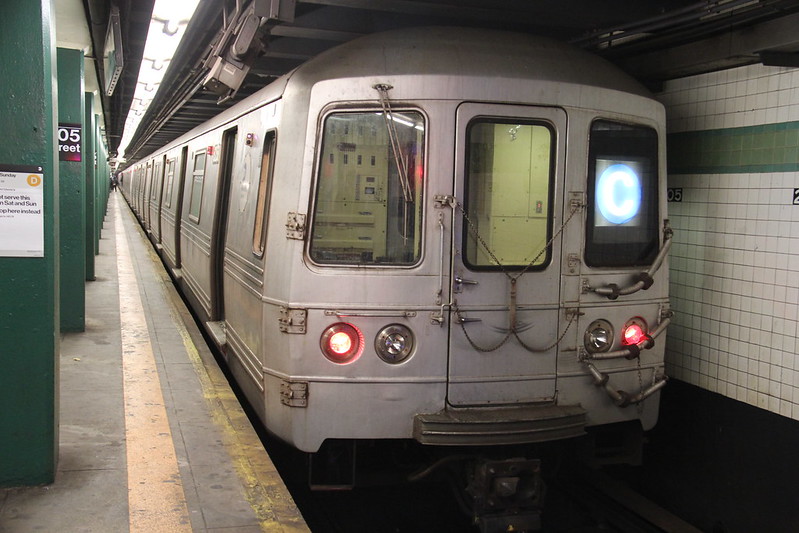 IMG_8420 by GojiMet86, on Flickr
IMG_8420 by GojiMet86, on Flickr
 IMG_8424 by GojiMet86, on Flickr
IMG_8424 by GojiMet86, on Flickr
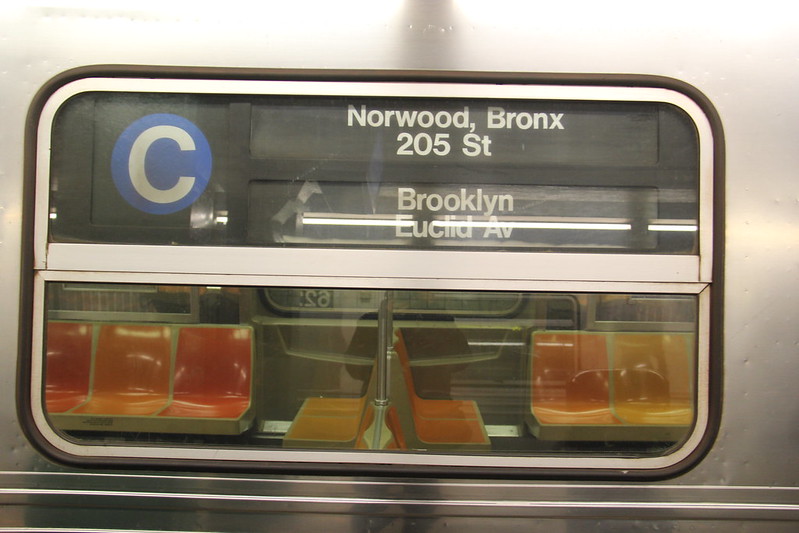 IMG_8426 by GojiMet86, on Flickr
IMG_8426 by GojiMet86, on Flickr
 IMG_8427 by GojiMet86, on Flickr
IMG_8427 by GojiMet86, on Flickr
 IMG_8430 by GojiMet86, on Flickr
IMG_8430 by GojiMet86, on Flickr
 IMG_8432 by GojiMet86, on Flickr
IMG_8432 by GojiMet86, on Flickr
 IMG_8441 by GojiMet86, on Flickr
IMG_8441 by GojiMet86, on Flickr
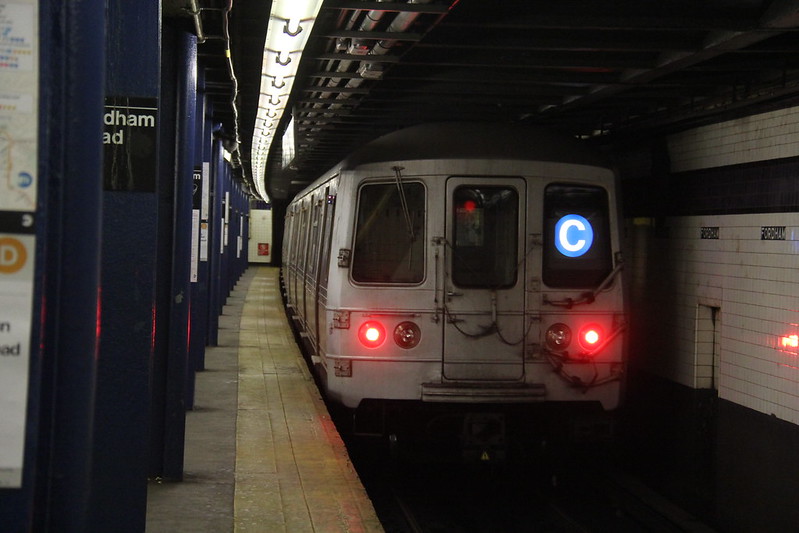 IMG_8444 by GojiMet86, on Flickr
IMG_8444 by GojiMet86, on Flickr
 IMG_8460 by GojiMet86, on Flickr
IMG_8460 by GojiMet86, on Flickr
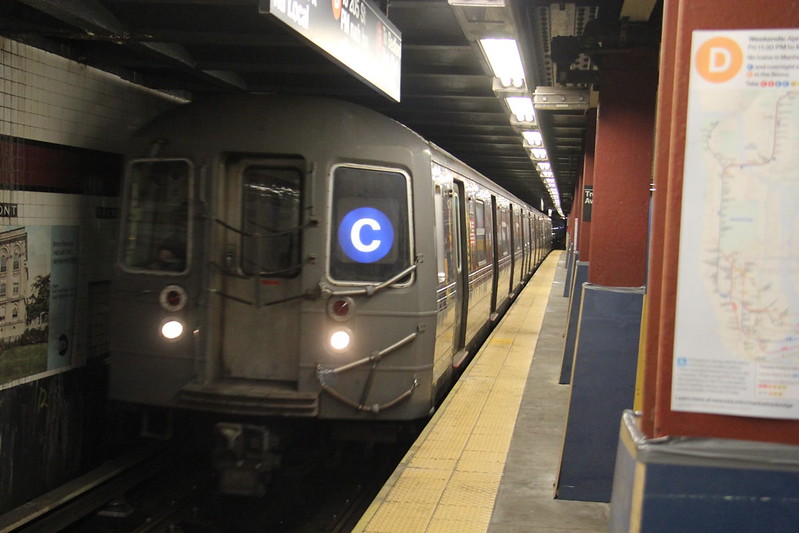 IMG_8484 by GojiMet86, on Flickr
IMG_8484 by GojiMet86, on Flickr
 IMG_8494 by GojiMet86, on Flickr
IMG_8494 by GojiMet86, on Flickr
 IMG_8496 by GojiMet86, on Flickr
IMG_8496 by GojiMet86, on Flickr
 IMG_8511 by GojiMet86, on Flickr
IMG_8511 by GojiMet86, on Flickr
 IMG_8514 by GojiMet86, on Flickr
IMG_8514 by GojiMet86, on Flickr
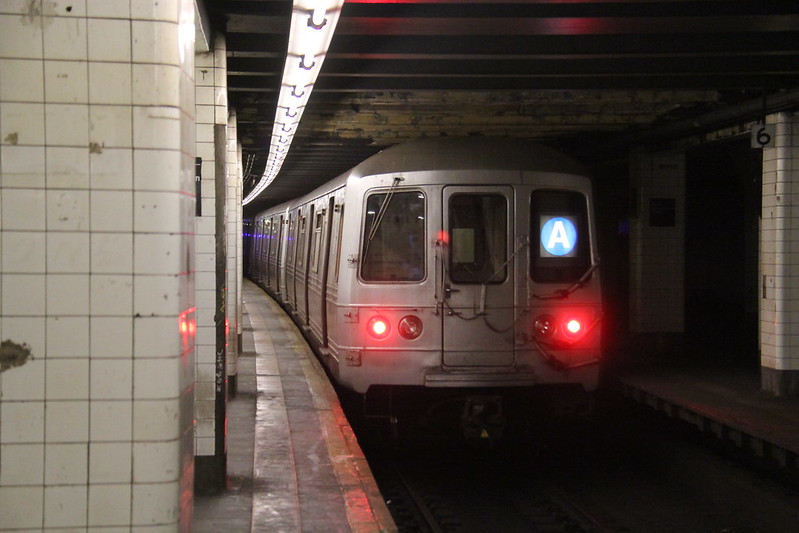 IMG_8573 by GojiMet86, on Flickr
IMG_8573 by GojiMet86, on Flickr
 IMG_8579 by GojiMet86, on Flickr
IMG_8579 by GojiMet86, on Flickr
 IMG_8581 by GojiMet86, on Flickr
IMG_8581 by GojiMet86, on Flickr
 IMG_8593 by GojiMet86, on Flickr
IMG_8593 by GojiMet86, on Flickr
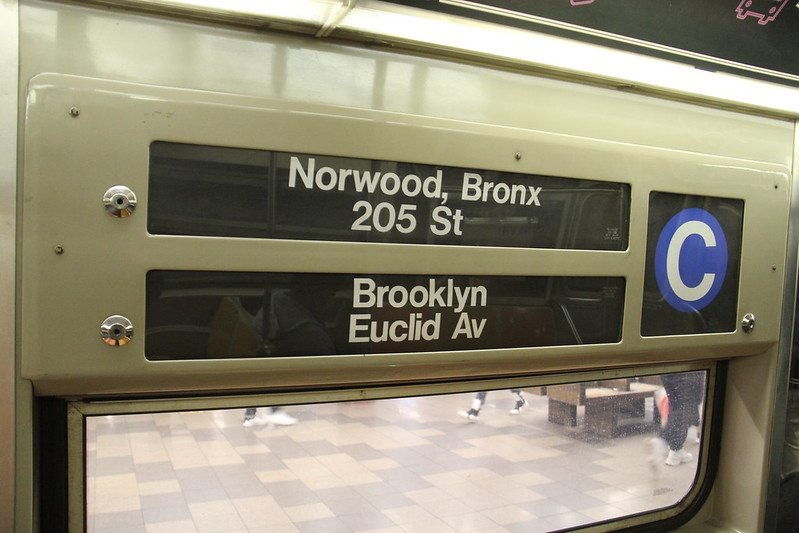 IMG_8595 by GojiMet86, on Flickr
IMG_8595 by GojiMet86, on Flickr
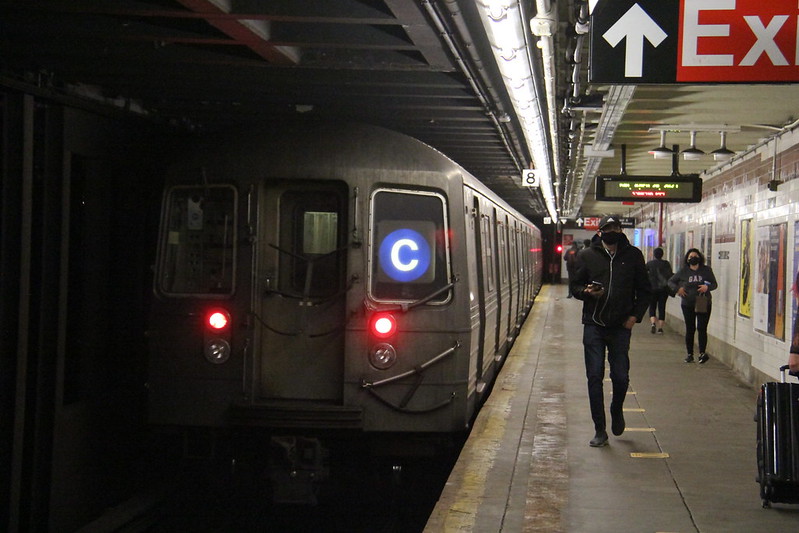 IMG_8597 by GojiMet86, on Flickr
IMG_8597 by GojiMet86, on Flickr
 IMG_8623 by GojiMet86, on Flickr
IMG_8623 by GojiMet86, on Flickr
 IMG_8630 by GojiMet86, on Flickr
IMG_8630 by GojiMet86, on Flickr
 IMG_8632 by GojiMet86, on Flickr
IMG_8632 by GojiMet86, on Flickr
 IMG_8638 by GojiMet86, on Flickr
IMG_8638 by GojiMet86, on Flickr
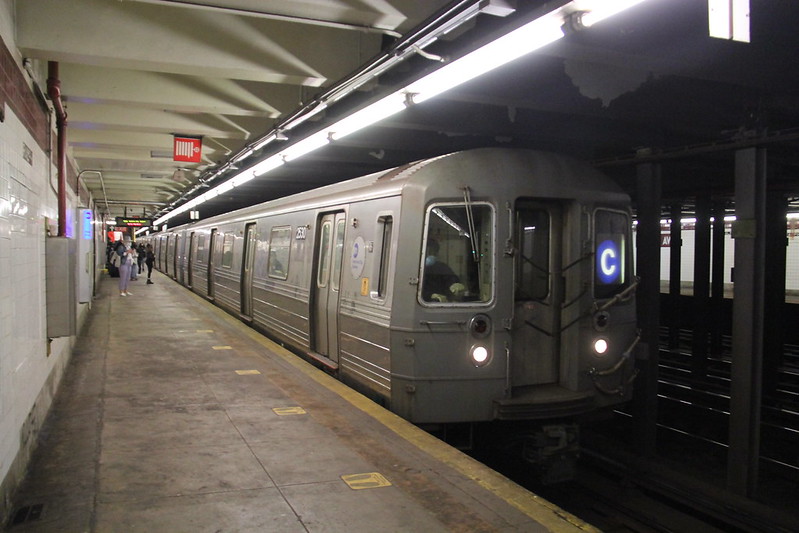 IMG_8652 by GojiMet86, on Flickr
2
IMG_8652 by GojiMet86, on Flickr
2 -
Pretty interestind read from a British transportation blog, London Reconnections. I decided to post this thing in its entirety so that people anyone can read along, or in case something ever happens to the website.
Thought this might be relevant to people who want to advocate for transportation in one way or another.
https://www.londonreconnections.com/2021/the-path-to-public-transport-enlightenment/
THE PATHS TO PUBLIC TRANSPORT ENLIGHTENMENT
By Long Branch Mike
Advocating public transport improvements is often an exercise in long term frustration. Decades can go by with only poorer service and line closures. But there is a way to work through these feelings. A lot of it has to do with understanding human nature.
This is a guide to the different ways the general public, and advocates, perceive public transport improvements, and the potential to increase their knowledge of what’s involved in getting public transport projects support, funding, and approval.
Herein we describe a method to avoid falling into the well of bitterness, keeping sanity and hopefully serenity, and making a difference. It can actually become a spiritual journey, accepting the things we cannot change, the courage to change the things we can, and the wisdom to know the difference. You can be the change you want to see in others.
THE SPECTRUM OF PUBLIC TRANSPORT ADVOCACY
Let’s start by identifying some of the stages in public transport awareness:
0 - Neutral on public transport (may not use it or know anyone who does).
1 - Likes trains, trams, or buses, and/or understands that they are important for towns and cities, allowing people who can’t or don’t want to drive to get around.
2 - Wonders why there aren’t way more public transport, trams, and/or buses. If angry, blames the transport authority.
3 - Starts thinking of ideas for new lines or services.
4 - Actively participates in discussions about appropriate public transport mode, vehicles, lines, and/or priorities.
5 - Reads rail and transport articles, news regularly, and starts to realise the cost, funding, political priorities, or underlying culture limitations to expanding transport.
6 - Joins a public transport advocacy organisation to actually push for improving public transport.
7 - Understands competing points of view on public and road transport, and that transport authorities are beholden to elected leaders’ goals and funding.
8 - Understands transport authority and political realities, and not blaming them outright (each has good and bad points).
9 - Zen state of accepting limits of what one can reasonably do to move sustainable transport forward.
10 - Actively works to educate others, communicate with elected officials, write a blog or YouTube channel, joins with others to constructively communicate positive ideas.
Not all transport enthusiasts and advocates necessarily follow this progression, nor necessarily experience all these stages. It’s a spectrum of attitudes and behaviours we have observed, with individuals fitting in to some and not others.
AVOIDING THE DEPTHS OF DESPAIR
There are also those who are against public transport, for a number of reasons:
1. New mass transport will get the car and bus in front of me off the road.
2. NIMBYs – Not In My Back Yard (transport improvement is fine, but not near me).
3. BANANAs – Build Absolutely Nothing Anywhere Near Anyone.
4. Invest nothing in transport networks – it’s a waste of money (the CAVE Brigade – Citizens Against Virtually Everything).
5. Completely shut down public transport networks, and give over the infrastructure to cars and expressways.
Many on the negative side of the spectrum believe the private sector is better able to fulfill transport need, but this has lead to street and chaos with jitney buses, unregulated taxi services, and greatly increased congestion and pollution in third world cities. And increasingly in first and second world cities thanks to the likes of Uber and Lyft clogging street and sharply reducing bus reliability.
Some of these levels are particularly susceptible to bitterness and anger. This is understandable, but these behaviours just put others off. They also work to tar fellow advocates working to foster communication and goodwill with public transport authorities and allies. Perception is reality for most people.
By all means have a healthy debate, but overly simplistic monochrome ‘authority X is bad’, ‘authority Y sucks’ positions are misleading, as there are many competing factors that are in play for public transport authorities – the politicians they report to, the multiple levels of government funding promised and available, environmental review laws, etc. Similarly, ‘LRT is bad’, ‘BRT is better than LRT’, ‘cut and cover is bad’ blanket statements ignore the critical local geographical, infrastructural, political context, and funding issues.
KNOWLEDGE OF INTERNATIONAL EXAMPLES
There is a separate and independent axis for individuals and groups on thePublic Transport Advocacy Spectrum. That is the level of awareness of other cities’ lines, modes, and operations. This too tends to be a progression, as follows:
- Line(s), mode(s), and system that the person uses
- Lines, modes, and systems that the person doesn’t use (could be commuter regional rail, lines, or mode(s) in a neighbouring city.
- Other lines, modes, and systems in the person’s country
- International lines, systems, and modes
This progression generally leads to an awareness of best practices per urban form, mode, and technology.
Note that it is easy to fall into a bitter place by comparing much better public transport elsewhere (like in Europe, in Japan…), believing that everything is always better somewhere else. The fact is that even well run systems have flaws, they don’t optimise all transport aspects. The goal is to stay out of bitterness, so we can better carry the public transport message to others. Nothing puts off people more than anger and bitterness. Gratitude for what we have, and focusing on positives, is the antid.
PLANNING AN OPERATIONAL RAILWAY IS A SERIES OF TRADE-OFFS.
To build a new line, public transport authorities and supporting governments have multiple criteria to satisfy:
- Physical Engineering – how the line would be constructed, options, and estimated costs
- Regulatory – environmental assessment and consultation processes, land use changes, union participation in some locations
- Legal – laws regarding environmental assessment, property acquisition, land use change process
- Contractual – design, construction, rolling stock, signalling, testing, operation, and maintenance
- Socio-Economic – the situation(s) that create the demand that would make a line or extension viable, and to determine options (to serve a new or isolated residential or business area, and the relative merits and costs of elevated, surface, in road median, or underground routing).
- Culture – will residents accept lengthy cut and cover tunnel construction, or elevated segments? What about appropriation of houses or apartments?
All western public transport authorities need to satisfy all six of these criteria, albeit to different extents and restraints according to the country, region/province/state, and city.
No public transport authority does everything well. Most focus on their highest ridership rail networks, and buses are often not as prioritized for funding even though they may carry more people than the city or region’s rail network. Riders and politicians prefer rail modes to ride and invest in. For many, creating a bus lane does not have the cachet of opening a light rail or streetcar line, even if the added capacity is equivalent.
REGULATIONS
Public transport authorities often receive funding which requires them to satisfy requirements over and above general corporate and labour requirements: environmental laws, railway operating requirements, transport worker hours, etc. And unfortunately, a lot of labour-management relations are legally structured to be adversarial, and as such the system is always inefficient. So both sides push for whatever they can get, to the detriment of efficiency and of the passenger.
THE FORCES OF ACTION AND REACTION IN PUBLIC TRANSPORT
For each public transport improvement action, there is an opposite reaction. But unlike Newton’s Law of Motion where the opposite reaction is equal in force and direction, in public transport the reaction often comes from all directions, sometimes from some public transport advocates, and the force of these reactions varies enormously. It is often like a multi-dimensional jelly that bulges out in odd ways in response to being prodded. Reactions are typically along one or more of these vectors:
- Cost – tax increase to pay for it, separate fare for new line, surcharge for new airport line etc
- Space/Land – ie taking away road lanes or access, stations requiring key real estate, gentrification, increased densities
- Priority – at traffic signals, LRT/bus lanes, vs road projects etc
- Time – time savings are insufficient, construction will take too long etc
- Capacity – too much or too little, unnecessary or in the wrong location(s), &c
- Congestion – a new line will attract more traffic, noise, pollution, and/or undesirables, and reduce safety
ALIGNMENT CHARTS
Insight can even come from general internet, for instance the Alignment Chart memes that have sprung up in the last couple years. Often humorous and subjective, they typically contain kernels of truth, and provide an easy way to compare and contrast technology, modes, applications, and justifications.
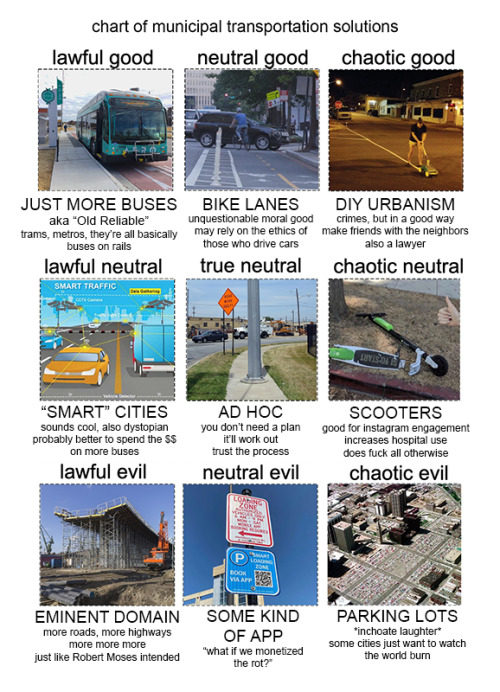
Alignment Charts can be drawn up for individuals, as personality types, as well as for objects. The charts have their origins in the Dungeons & Dragons role playing game, of all places. But such simplistic charts can assist, if only subjectively and coarsely, in identifying and categorising technologies, modes, objects, and personalities.
A YOUNG PERSON’S GUIDE TO PUBLIC TRANSPORT ADVOCACY
To be considered seriously by transport authorities and politicians, the following attributes are essential:
- Pragmatism
- Understanding the other side’s point of view
- Adult and professional behaviour
- Trust
- Using case studies and data in context
These are all critical to advance up the Ladder of Public Participation:
ARNSTEIN’S LADDER OF PUBLIC PARTICIPATION
Sherry Arnstein was a planner who in 1969 developed this ladder of public participation, which is useful to refer to as in relation to proposed public transport schemes.
NON PARTICIPATION
1. Manipulation The aim is to educate the participants as the proposed plan is best and the job of participation is to achieve public support by public relations.
2. Therapy The aim is to educate the participants as the proposed plan is best and the job of participation is to achieve public support by public relations.
TOKENISM
3. Informing A most important first step to legitimate participation. But too frequently the emphasis is on a one-way flow of information. No channel for feedback.
4. Consultation Attitude surveys, neighbourhood meetings and public enquiries. But Arnstein still feels this is just a window dressing ritual.
5. Placation For example, hand-picked ‘worthies’ onto committees. It allows citizens to advise or plan ad infinitum but retains for power holders the right to judge the legitimacy or feasibility of the advice.
CITIZEN CONTROL
6. Partnership Power is in fact redistributed through negotiation between citizens and power holders. Planning and decision-making responsibilities are shared eg through joint committees.
7. Delegated power Citizens holding a clear majority of seats on committees with delegated powers to make decisions. Public now has the power to assure accountability of the programme to them.
8. Citizen Control Have-nots handle the entire job of planning, policy making and managing a programme eg neighbourhood corporation with no intermediaries between it and the source of funds.
HOW TO DESTROY TRUST
- Binary black or white thinking (it is lazy, inaccurate, and ineffective)
- Personal attacks on transport authority executives and staff, on politicians, and on other transport advocates
These traits only attract others with the same issues, which is not a basis for constructive dialog with authorities or conducive to positive change:
- Bitterness
- Anger
There is often a lot to be frustrated about with the lack of progress and funding for public transport. But deep anger needs to be channelled and retuned into positive actions, lest the anger and bitterness grow.
Transport authorities and politicians take the opinions of groups much higher than individuals in meetings, consultations, and submissions. In the UK, some bus and rail users groups, being focused on a single bus network or rail line, can look at the issues in detail.
There’s a lot in the world of campaign strategy and social change that looks at this sort of thing. Some groups attend public meetings and talk politely, whilst others take direct action to protest for or against:
GRAHAM’S HIERARCHY OF DISAGREEMENTS
Programmer, Harvard PhD, entrepreneur, VC capitalist, and writer Paul Graham elucidated this list. The force of a refutation depends on the method of addressing the argument. The disagreement hierarchy forms a pyramid, in the sense that the higher you go the fewer instances you find.:
- Refutation – The most convincing form of disagreement, and the rarest as it’s the most work.
- Counterargument – Contradiction with reasoning and/or evidence.
- Responding to tone – responses to the writing, rather than the writer. The lowest form of these is to disagree with the author’s tone.
- Ad Hominem – ‘Of course he would say that. He’s a politician.’ It doesn’t refute the argument, but it may be relevant.
- Name-calling – The lowest form of disagreement, the easiest, and the most common unfortunately.
GLASL’S MODEL OF CONFLICT ESCALATION
Dr Friedrich Glasl is an authority on conflict, and he developed this model to assist in the analysis and de-escalation of conflicts. The model has nine stages grouped into three levels, each containing three stages, which can be applied to any kind of conflict: in particular, it applies between and among transport authorities and advocates.
1ST LEVEL (WIN – WIN)
STAGE 1 – TENSION
Occasional clash of opinions but is not perceived as the start of a conflict.
STAGE 2 – DEBATE
The parties consider strategies to convince the counterparty of their arguments which leads to dispute, and the parties try to put each other under pressure, and start thinking in terms of black or white.
STAGE 3 – ACTIONS INSTEAD OF WORDS
The parties increase the pressure on each other in order to assert their own opinion. Verbal discussions are broken off and sympathy for the other party disappears.
2ND LEVEL (WIN – LOSE)
STAGE 4 – COALITIONS
Each party searches for sympathisers to their cause. Belief of right on one’s side, one can denounce the opponent. The issue is no longer important: one has to win the conflict so that the opponent loses.
STAGE 5 – LOSS OF FACE
The opponent is denigrated by innuendo and similar actions. The loss of trust is complete. To lose face would mean a loss of moral credibility.
STAGE 6 – THREAT STRATEGIES
The parties try to gain control by issuing threats which demonstrate their power. The proportions decide the credibility of the threat.
3RD LEVEL (LOSE – LOSE)
STAGE 7 – LIMITED DESTRUCTION
One tries to severely damage the opponent with all the tricks at one’s disposal. The opponent is no longer regarded as human. From this point onwards, limited personal loss is seen as a gain if the damage to the opponent is greater.
STAGE 8 – TOTAL ANNIHILATION
The opponent is to be annihilated by all means.
STAGE 9 – TOGETHER INTO THE ABYSS
At this point personal annihilation is acceptable if it means defeat of the opponent.
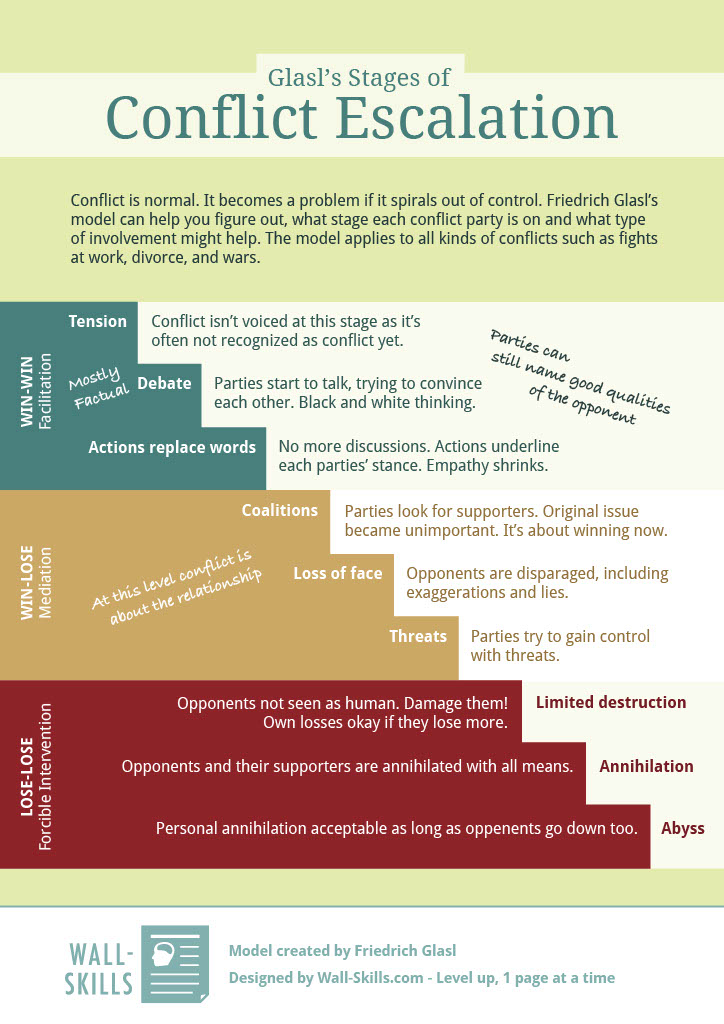
STRATEGIES FOR DE-ESCALATION AND CONFLICT SOLUTION
But there is hope, even though solutions for de-escalation are often not immediately apparent. Particularly when both parties don’t want to or believe be impossible to reverse the situation, or when one party selects escalation as a strategic ploy. To de-escalate, Glasl suggests the following:
Stages 1–3: Mediation
Stages 3–5: Process guidance
Stages 4–6: Socio-therapeutic process guidance
Stages 5–7: Intercession, intermediation
Stages 6–8: Arbitration, court action
Stages 7–9: Forcible intervention
THE JOB IS EDUCATION
Education of others of the principles of public transport, its relation to land use, and the importance of service frequency is a major task for advocates. These are complex, inter-related issues:
- Land use
- Road use
- Public transport options
- Existing transport modes
- Political choices
Simplistic reduction of them glosses over too many nuances and lead to misunderstandings and myths. Binary thinking is too easy, and poisons the well of intelligent discourse.
SILOS OF TRANSPORT RELATED DISCIPLINES
In the UK, transport management and planning is taught with little or no awareness or reference to urban and town planning. This is despite the close relation between urban structure and density with the need and demand for public transport.
In the real world, perfect public transport lines rarely exist. A flawed transport authority can still build a good line, and a good transport authority can build a line with deep flaws.
WHY PEOPLE RESIST CHANGE – SCHULER’S TEN REASONS
- The individual’s personal predisposition to change.
- Surprise and fear of the unknown.
- Climate of mistrust.
- Fear of failure.
- Loss of status and/or job security.
- Peer pressure.
- Disruption of cultural traditions and/or group relationships.
- Personality conflicts.
- Lack of tact and/or poor timing.
- Not seeing the benefits.
Everyone gets frustrated with public transport authorities. The people inside of them get frustrated too. Getting angry at a public transport authority rarely has much effect. To influence someone, start by thinking about transport from their point of view.
CONFUSING DIRECTION FROM ELECTED OFFICIALS
Often without intending to, elected officials provide conflicting goals, like increased ridership at a lower overall budget. Many managers would not pressure officials to be clearer about which is the higher priority.
There is often a difference in attitudes between transport authority (who generally want to improve public transport) and the elected politicians which oversee it (who generally bow to the car driving voter). This is really important, but it is not clear in the minds of most of the public.
OPERATIONS RESIST CHANGE
The dominant task of most public transport operators is running the service to schedule every day, and most staff are focused on that. Disruption and change are generally avoided.
Most people and organisations are quite afraid of change. Change means that what staff did yesterday could be completely different going forward: new bosses, new evaluation criteria, retraining, moving divisions…
Hence having a pilot, or a nearby city demonstrating a mode, technology, or transport innovation is crucial to point to so that people can see for themselves how well it works.
Because operations is the dominant part of most authorities, they tend to define the authority’s culture.
MISDIRECTED BLAME
Many aspects of the success or failure of a public transport system are outside the public transport authority’s control. Like traffic, accidents, road and building construction, and their own budget.
Passengers typically blame the operator or transport authority for running late and slow buses, without often considering what priority measures (bus lanes, signal prioritisation) that the authority could prioritise buses. Or that it’s the city and its politicians who have decided this, directly or indirectly, by cutting transport funding and/or hiring malleable staff.
When a planning process seems bureaucratic and unresponsive, do you blame the Federal rules that they have to follow, or do you just blame the public transport authority?
When a public transport authority’s ridership falls, riders and the public don’t often consider external causes like low gas prices, Uber/Lyft proliferation, etc.
When a public transport authority proposes a new line, which usually results in sticker shock, riders and the public rarely consider the soft benefits of decreased pollution, improved network coverage, network resiliency, line-wide accessibility, and importance to following generations. These are all difficult to quantify in monetary terms.
When there is insufficient service, do riders and the public blame the public transport authority, or look at the elected leaders (and voters) who refuse to fund public transport properly?
Public transport authorities are constantly blamed for things they don’t control, which leads to:
PUBLIC ABUSE
Yelling at authority staff or other advocates is not a good way to communicate. The reaction then is that they become more defensive and less open with ideas and information. The best people rise above this. But they also want understanding and support from advocates, who want the same goals – services provided, improvements implemented. Both the users and the transport authority need to educate the elected leaders on the importance of the public transport in question – the transport authority is rarely the villain. Typically it has been starved of funds, resources, and initiative. Those that control the purse strings are the ones ultimately responsible.
At best, the public transport authority service is unremarkable – people take transport vehicles, get to where they are going as expected, nothing unusual. Appreciation for providing stable, reliable service in normal conditions is rare. But as soon as service is disrupted, for whatever reason, the authority and its operators are the first point of contact. And blame.
It’s also important for advocates to be seen as reputable and trustworthy by the mainstream media, as a source of facts, rational thought, and a counter weight to NIMBYs, politicians, and stubborn transport authorities.
Most public transport authority staff also really want to improve their system, and often share advocates’ opinions and goals.
THE DANGER OF THE TECHNUTOPIANS
Autonomous vehicles, maglevs, Hyperloops, flying taxis, on demand transport – these are all unproven gadgetbahn technologies with at least a decade to widespread use. And they are always a decade away, ever shunting into the future. They are not mass transport solutions for cities, and will not be for the foreseeable future. Hence Reconnections does not waste time on them. ***
At best, they are a distraction. But the reality is that these shiny baubles are pulling in billions in investment funding and government support that will benefit millions fewer passengers than if the money were instead invested in proven public transport modes and services.
SUMMARY
The goal of this piece is not to shame or put down advocates, but to provide a path on how to improve, whilst maintaining a positive, constructive attitude, if they so wish. ***
Without an informed public and an informed debate, public transport policy and development will forever be stuck in the trench warfare of advocates and critics, lobbing grenades at each other over a no man’s land of wilful ignorance of each other’s views and perceptions.
The standard of debate about transport planning in Britain is woeful, even amongst those who should know better. One real problem is that many people are obsessed with the mode they know the best, and are generally unwilling to accept that a range of transport problems will need a range of different modes to deal with them. It is often difficult for people to comprehend a scheme that doesn’t use their favourite mode and will actively denigrate other transport modes.
0 -
8 hours ago, Lawrence St said:
The worse by far is SecondAvSagas, all he does is complain about the lack of transit but then complains about the city trying to make better transit. You can never win with these politics lmao.
Wait......what? How did you get the idea that Vanshnookenragen or Benjamin were against transit? In those tweets, Vanshnookenragen clearly means that the QueensWay park is a waste. Dude has been trying to advocate for a hybrid subway line AND park here: https://twitter.com/thequeenslink
3 -
https://whyy.org/articles/we-need-to-adapt-septa-launches-25-million-bus-system-redesign/
Quote‘We need to adapt’: SEPTA launches $25 million bus system redesign
By Darryl C. Murphy April 28, 2021
SEPTA is gearing up for a revolution — a Bus Revolution.
The transit authority, Wednesday, launched its long-awaited comprehensive bus network redesign with a name to reflect the grand ambitions of the $25 million overhaul.
“We’re taking a complete blank-slate look at SEPTA’s bus network, making sure that the bus routes are going to the right places at the right time and carrying and operating as efficiently and effectively as possible,” said Bethany Whitaker, project manager and principal at Nelson/Nygaard, the consulting firm contracted to lead SEPTA Forward: Bus Revolution.
The authority will release a web and phone survey on Thursday to begin gathering insight from riders to inform the three-year overhaul of its bus network. It’s likely some riders will encounter consultants asking about their experience commuting as early as Monday. SEPTA signed a $3 million contract with Nelson/Nygaard for the plan last December.
“I think one of the really important things for us to do is to get to know Philadelphia really well,” said Geoff Slater, another principal at Nelson/Nygaard’s Boston office. “I think if you try to ask us questions, detailed questions about Philadelphia today, you can probably trip us up a lot. But six months from now, we hope that you wouldn’t be able to trip us up.”
The first year of the three-year project will be dedicated to gathering data, evaluating transit needs, analyzing individual bus routes, and engaging the public. After that, the plan is to develop options for service improvements, gather public input, and issue a final set of recommendations. Implementation is expected to take place in the third year of the project.
SEPTA’s legacy transit infrastructure goes back more than a century, long before its own beginnings in 1963. The fairly new transportation authority purchased its city transit division in 1968 from then-owner Philadelphia Transportation Company, reportedly the world’s largest privately-owned transit system at the time.
Since then, changes in neighborhood race and class dynamics, work schedules, and even technology have changed the city, creating a mismatch between the routes and riders’ needs. The comprehensive redesign project promises changes to bring SEPTA up to speed.
A 2018 study included suggestions such as eliminating duplicative route segments, wider distances between stops to quicken rides, all-door boarding, focused service on transportation centers, and elimination of the transfer fee. Many of the recommendations aim to speed up bus service.
Initially, SEPTA sought to address sagging bus ridership and competition with ride-hailing services, but the COVID-19 pandemic has introduced a whole new set of challenges as more would-be commuters work from home and many remain reluctant to return to the service.
Officials report that the authority loses about $1 million per day at the farebox. For months, SEPTA reports had transit ridership at 35% of pre-pandemic levels, but last month that number inched up to 38%.
“Ridership has started to rebuild,” Whitaker said. “Through that process, we are learning a lot, including who needs the bus the most, who the reliable riders are when they’re traveling, where they need to go. That is really the road map to the core of the network.”
The pandemic also brought new travel patterns and more attention to racial justice has highlighted the importance of an equitable network, the Nelson/Nygaard planner said.
“I think we tended to have a little bit of a one-size-fits-all approach to transit service planning,” Whitaker said, noting the mistakes of the past. As more people find work in service industry jobs and the nature of work shifts, transit needs to shift too, she said, pointing to increased demand for service on Saturdays.
“We need to respond and adjust and adapt to that,” she said
Slater said the firm is likely to recommend permanent changes to peak service to provide more service during the midday, weekends, and evenings and “a greater focus on the non-work trips.”
Pending approval from the board in June, the bus network redesign will guide the $25 million capital investment in bus infrastructure. The authority plans to make improvements that include right-of-way enhancements, bus wayfinding, end of line bus facilities, and enhanced stops.
The authority also plans to purchase 220 new buses between FY2022 and FY2024. The goal is to retire the last of its diesel fleet and is looking to move toward a zero-emission fleet with battery-electric buses.
The authority rolled out the buses on select routes in June 2019 then took them out of service in February 2020. The sidelining was due to a defect in the plastic chassis of the vehicles that leads to cracking, according to agency sources.
SEPTA spokesperson Andrew Busch said the buses are still under warranty and the authority has had some “some productive discussions” with the buses’ manufacturer Proterra about “making the fixes that can be made to get them out in service.”
In the meantime, Whitaker said such technology is not much of a factor in the redesign. The current focus is “service planning and understanding the service demands and needs.”
“We’re a little bit less worried about the vehicle technology,” Whitaker said. “But when we circle back and talk about implementation, then we’ll take that into consideration.”
0 -
It's just not me, then.
The huge Google Vignettes are the worst. They take the whole page up, even on the desktop, and half the time the "X to Close" isn't even there.
0 -
5 minutes ago, MeeP15-9112 said:
What were these things used for? I vaguely remember seeing them on NYCT buses (and never any BusCo buses), and they were removed from almost all of the fleet (ik 2910 has one still).
Anything that NYCT had that was built before the Orion VII Gen 2+ seems to have had these installed.
http://web.mta.info/nyct/materiel/collectsales/pdfs/mc12072.pdf
Used to tell any inspectors on the bus if the person paid the fare. They were removed after one of them fell on a passenger.
1 -
Looks like the Gilligs will have the BRT styling front. Photo courtesy of Steve Souza:
 1
1 -
1 minute ago, Deucey said:
You really wanna steal all that parking and the walkway from the folks going to the casino?
You hate Long Islanders and old people, huh?
/Sarcasm
Don't forget the gold courses, too.
1 -
I've been working a fantasy map for a while (okay, maybe some 8 years now), but I never put much thought into the yards.
Two of my lines would be a
 from Forest Hills to Bay Ridge via 2nd Avenue, not Broadway. Another would be a
from Forest Hills to Bay Ridge via 2nd Avenue, not Broadway. Another would be a  from the two Rockaways to Hanover Square, again via 2nd Avenue and not 6th Avenue. Both would probably use a new tunnel under 57th Street to reach 2nd Avenue and run on their own tracks, seperately from the
from the two Rockaways to Hanover Square, again via 2nd Avenue and not 6th Avenue. Both would probably use a new tunnel under 57th Street to reach 2nd Avenue and run on their own tracks, seperately from the  and a (U) running on their own tracks, while the
and a (U) running on their own tracks, while the  and
and  would use the 63rd Street tunnels.
would use the 63rd Street tunnels.
Now I can see the
 using Jamaica Yard, but the bulk of the
using Jamaica Yard, but the bulk of the  would have more difficulty getting there. Trains would have to finish their runs in Manhattan and then head back to Queens.
would have more difficulty getting there. Trains would have to finish their runs in Manhattan and then head back to Queens.
In this map, Jamaica Yard would house an extended
 , the
, the  , and the
, and the  , with some
, with some  trains, although a Rochdale yard would be used for the
trains, although a Rochdale yard would be used for the  to Rosedale.
to Rosedale.
Would it be worth it to expand Rockaway Park yard? I've been leaning heavily to no, because of flood risks....unless the yard is elevated and can occupy that land between Beach Channel Drive
How about making a curve from the Rockaway line, have it head east under the existing Queens Blvd line, and connect it with the Jamaica Yard leads? Maybe, but that would be a long 12-mile deadhead, and with 3, almost 4 lines using it, it might be strained to house 5 lines.
A third possibility would be a yard next to Aqueduct Racetrack. It would replace that huge parking lot in the south. The leads at the southern end would flyover and replace the current "express" tracks, descend and use the switches south of Howard Beach. The northern leads would do the same, but the flyover would descend within the Racetrack station and have switches north of the station.
Some maps:



Thoughts?
0 -
2 hours ago, 46Dover said:
Ohhh. That is close
Intentional, so that the revenue would go to the state and not the Port Authority. Same reason (or one of the reasons) why it was built at the widest point of the river. You don't build bridges at the widest points.
1 -
15 minutes ago, Lawrence St said:
A passenger on board my R46
 at 145th St Upper Level just screamed "ITS A F******
at 145th St Upper Level just screamed "ITS A F******  TRAIN JUST GET ON" cause people kept holding the doors open tryna figure out if it was a
TRAIN JUST GET ON" cause people kept holding the doors open tryna figure out if it was a  or a
or a  . 🤣
. 🤣
Sounds like a railfan to me......
0 -
Vendor in question is Suzhou Huaqi Intelligent Technology. Could not have picked a better acronym.
QuoteMTA pulls security cameras from NYC subway train due to vendor’s ties to Chinese facial recognition company
By CLAYTON GUSE
NEW YORK DAILY NEWS |
APR 22, 2021 AT 7:03 PM
The MTA on Thursday abruptly halted a program to test new security cameras on subway cars — a day after the Daily News raised questions about the ties the company providing the technology has to a Chinese firm that specializes in facial recognition technology.
Transit managers last week sent a memo to subway crews alerting them of new video cameras installed on a four-car G line train. The new tech is part of a years-long effort by the Metropolitan Transportation Authority to improve security and put more eyes underground.
The test program installed four cameras in each of the cars, as well a system that operated the train’s digital signage and intercoms, the memo states.
The cameras began monitoring passengers on the G line train last Thursday — and MTA officials planned to keep them there for a year to see how they worked.
But the vendor contracted to provide the system’s technology — Suzhou Huaqi Intelligent Technology — raised major security flags that prompted officials to suddenly pull the camera-filled train from service on Thursday.
The company in the first quarter of 2019 was acquired by Bii Railway Transportation Technology, a Chinese company that has ties to the country’s government and listed facial recognition technology among its specialties in its 2019 annual report.
MTA officials said they signed a deal with Suzhou Huaqi to test the cameras in January 2019, before the company’s acquisition was finalized. The agreement to test the technology for a year came at no cost to the agency and did not require approval from its board, officials said.
MTA spokesman Ken Lovett said transit honchos were not aware of the test cameras until The News began asking questions about Bii Railway on Wednesday.
“This short-term test and evaluation was designed to determine whether the equipment would meet New York City Transit requirements to qualify as a potential approved system for future subway car procurements,” said Lovett.
“Once leadership became aware of the test program, and questions were raised about control of this particular company, we ended the evaluation.”
It’s unclear whether the cameras ran on software that employed facial recognition technology. MTA chairman Pat Foye said “no facial recognition” was used in any subway security cameras during a news conference Wednesday.
A federal government source could not immediately tell The News whether Suzhou Huaqi or Bii Railway were subject to active inquiries by national security authorities.
But the source noted “the MTA’s plans to potentially move forward with this pilot initiative stand a very good chance of sounding alarm bells with the National Security Agency.”
MTA officials have over the last two years expanded the number of security cameras installed in subway stations and platforms — and plan to have nearly the whole system monitored by the end of the year.
The agency has no timeline to put cameras on every subway train — but transit officials said they’ve required all future subway cars the agency purchases to come equipped with CCTV.
The cameras in stations and platforms do not run on the same technology as the ones yanked from the G train, officials said.
It’s not the first time in recent years the MTA has run afoul with the feds over its relationships with Chinese companies.
Congress and former President Donald Trump in 2019 passed a measure in a defense spending bill that prohibits transit agencies from receiving federal subsidies for rail car purchases from China Railway Rolling Stock Corp., a company owned by the Chinese government.
The company was a winner of the MTA’s “Genius Transit Challenge” contest launched by Gov. Cuomo in 2017, and was awarded $330,000 for a proposal to design a lightweight, wifi-equipped subway car for the New York, and promised to invest $50 million of its own money in the project.
The ban on Chinese rail car purchases does not go into effect until 2022 — and the Chicago Transit Authority this week began testing a new series of subway cars purchased from the company.4 -
Always nice to see what's going on in the land down under. These are for the Melbourne Metro system, right? And are these the first to have the open gangway for walking between cars?
0 -
Yeah, 7603-7604 were brought out for the MTA press conference.
0 -
There's a recall for New Flyer XE40s, year models 2019, 2020, and 2021. Is there a chance that our electric New Flyers are affected?
Recall Details
Transport Canada Recall # 2021-206
Recall Date 2021-04-07
Last Updated 2021-04-15
Notification Type Safety Mfr
System Electrical
Issued by NEW FLYER
Manufacturer Recall Number R21-005
Units Affected The number of vehicles or components affected by the recall. 78
Category Bus
Recall Details
Issue:
On certain buses, an error in the inverter software may cause the electric drive system to shut down unexpectedly while driving. This could result in a loss of power to the wheels.
Note: The bus may be restarted again once it is brought to a full stop.Safety Risk:
A sudden loss of power to the wheels increase the risk of a crash.Corrective Actions:
New Flyer will notify owners by mail and instruct you to book an appointment with New Flyer field support to update the drive system programming.
Make Model Model Year(s) Affected
NEW FLYER XE40 2019 2020 20210 -
There's an 8-car R179 on the
 late-night shuttle right now.
0
late-night shuttle right now.
0 -
There's an 8-car R179 on the
 late-night shuttle right now.
0
late-night shuttle right now.
0 -
This bus was testing with NICE. Here's the FB post:
https://www.facebook.com/NewFlyer/photos/a.342999239482513/1137822036666892
Quote
This week New Flyer demonstrated our 35-foot Xcelsior CHARGE® #batteryelectric transit #bus to the Nassau Inter-County Express / NICE Bus team. We demonstrated the features and new technological advances our Xcelsior CHARGE® has brought to the market. Sustainable, #zeroemission, clean, and quiet #transportation - the Xcelsior CHARGE® from New Flyer!
1 -
If you guys wanted to see a C40LFR in MTA colors, here's one for a movie shoot in Los Angeles (photo belongs to a member of the Southern Cal Transit Fans FB group):

 7
7 -
Most of us forget that Long Beach has its own tiny system.
0




MTA Bus Operations: Scrapped Equipment List
in New York City Bus
Posted
Hmm, I think we're all using the same guy as a source. 😁
Actually, he just amended one of his posts to say that the buses are being sent to Eastchester......for actual MTA Bus passenger service.
So no scrapping...yet.